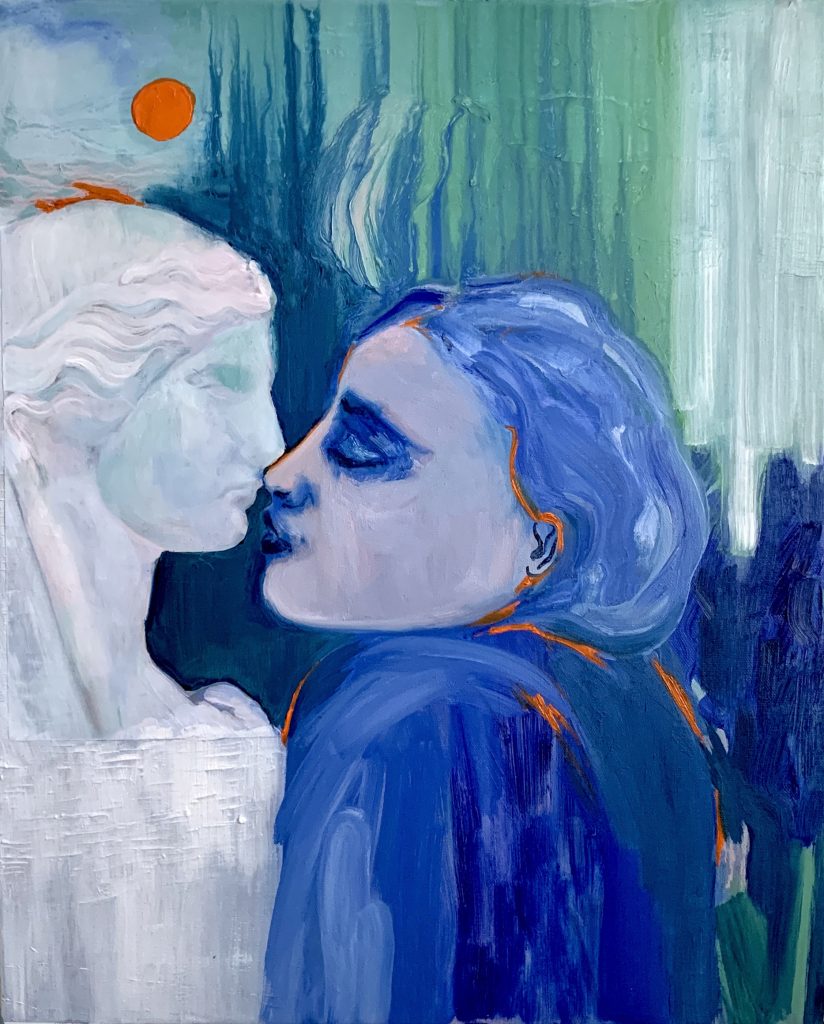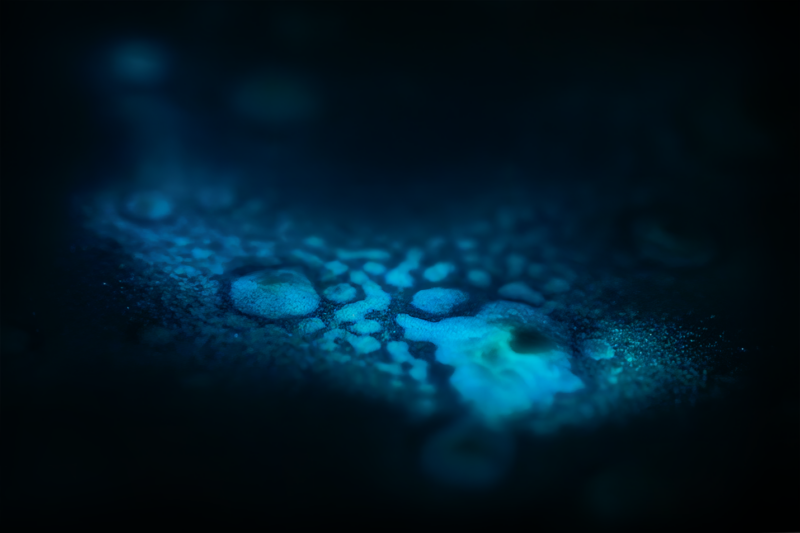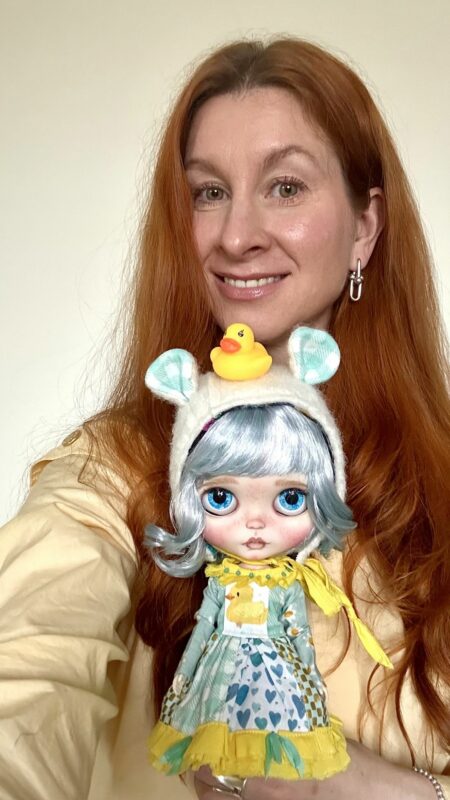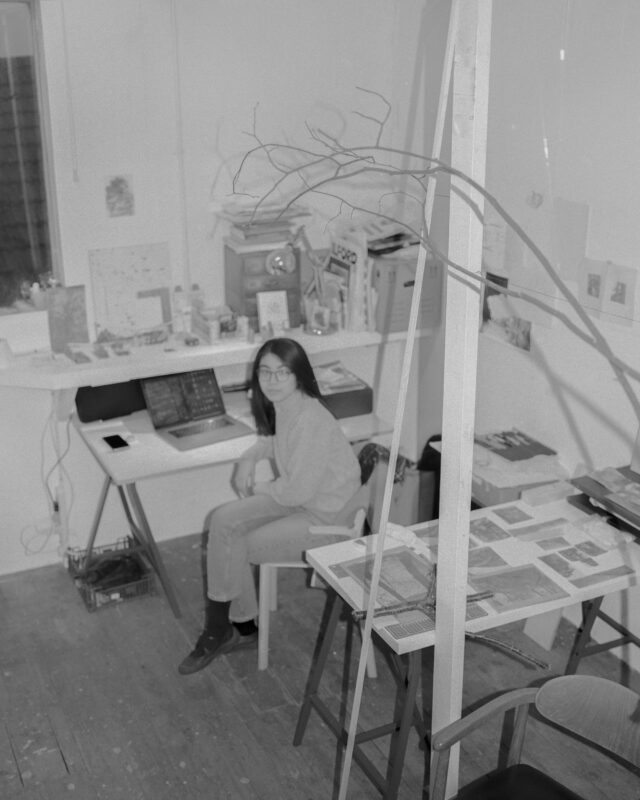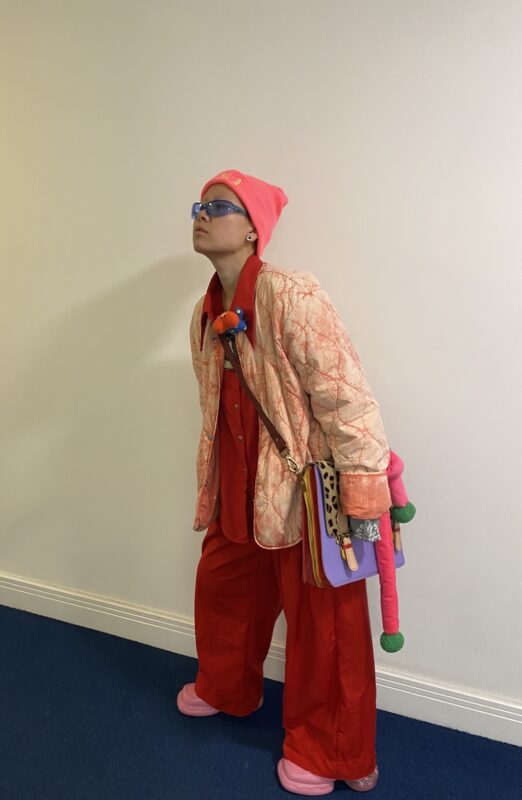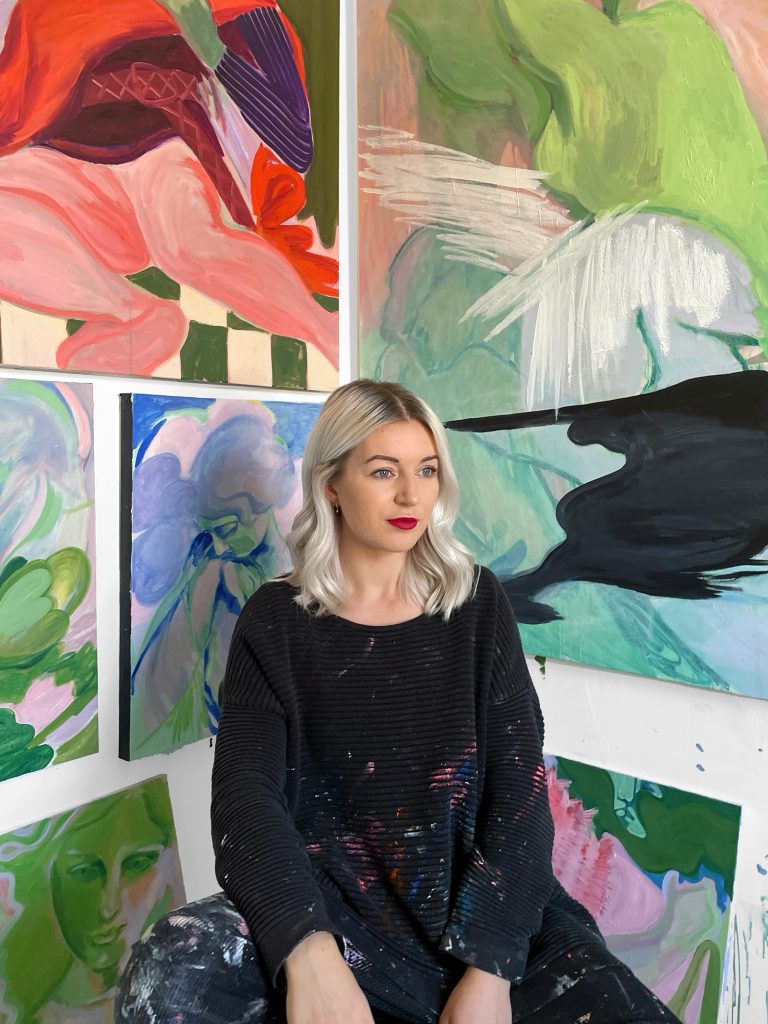
Artist Amy Beager spoke to Lee Sharrock about her career to date, the ‘Cassandra Syndrome’, her inspirations ranging from classical mythology to a famous Joy Division album cover, and her latest exhibition with Offshoot Arts on Artsy. Titled ‘The Torches Burn Bright’, Beager’s solo show features new oil and acrylic paintings inspired by Baz Luhrmann’s 1996 cinematic interpretation of Shakespeare’s ‘Romeo & Juliette’, putting a Millennial twist on an iconic Elizabethan love story with her vibrant Neo-expressionist painting style. One of the most striking paintings in the exhibition, titled ‘In Fair Verona’, is a diptych of the star-crossed lovers embracing and sleeping, their faces depicted with classical profiles that would be at home in ancient Rome, yet Beager’s visceral use of paint which sometimes drips down the canvas, and the pastel-tones of her palette evoking Neopolitan ice-cream on a summer’s day, lend the canvases a completely contemporary aesthetic.
Lee Sharrock: You obtained a National Diploma in Art & Designed and studied for a BA at Nottingham Trent University, but what was the seed that planted the idea of becoming an artist in your mind – did this happen at a young age?
Amy Beager: I wanted to be an artist at a young age, particularly whilst at school during my Art GCSE/ A-levels, but it didn’t seem like it could be a realistic career for me. During my Art Foundation, I started to learn other art related disciplines such as; screen-printing, photography, fashion design and sculpture. I was advised by the tutors to choose a BA in one of those areas that would offer a more secure career after graduating and also warned of the elitism and financial competition I would quite possibly have to face if I studied Fine Art. My father was Art Editor of a magazine at the time and had friends who were photographers, but I had no connections within the Fine Art world. I think it was a lack of confidence and knowledge that deterred me. I worked as a fashion designer for 7 years but started to create my own illustrations in the evenings and weekends, posting them to Instagram. I knew I wanted to eventually be a fine artist and felt that I could take the risk financially, with my design career to fall back on and I quit my job to go freelance in 2017 whilst building up my art practice.
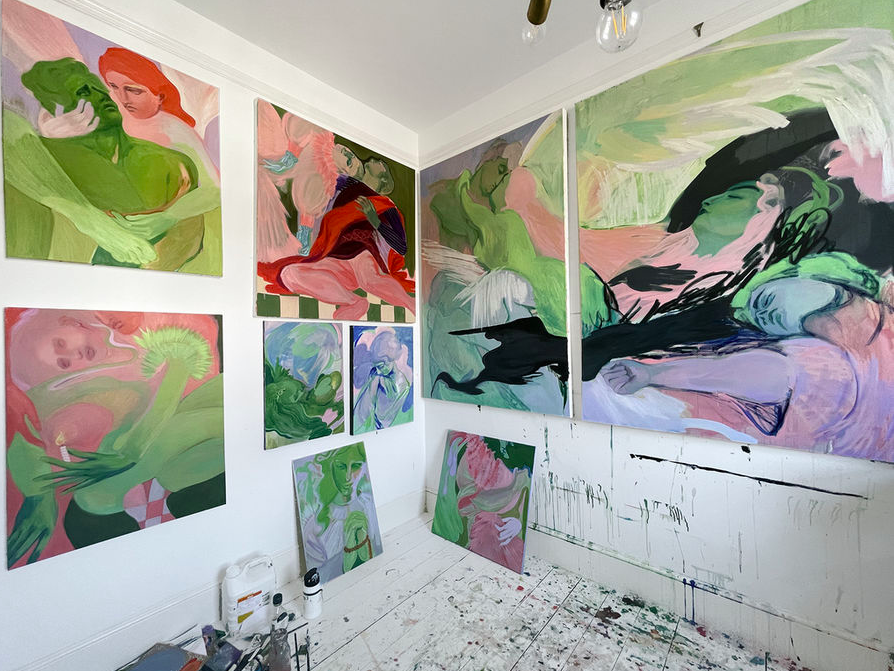
You won the Delphian Gallery open call in 2020. What effect did this have on your career, and was this when your work started being picked up for private collections?
Yes, I was selected as a ‘judges pick’s’ and a group winner for the Delphian Gallery open call 2020. It definitely had a huge impact on my career and I am extremely grateful to Ben & Nick at the Delphain Gallery for this. It impacted sales significantly and also seemed to open the door for me in regards to other galleries and exhibitions. I was already selling smaller original works on paper but I had only sold a couple of larger works before this. More importantly, It also gave me the confidence to develop my work further and to push myself to another level with my painting practice.
You work from a studio in Chelmsford. Do you think that not being situated in one of the traditional art world centers like London, Paris or New York has made any difference to your career, or do you feel that in our Uber-connected digital world, with so many artists raising their profiles via social media, that your location is no longer so relevant?
It’s only a 40min train journey into London Liverpool street, or an hour’s drive, so it’s pretty easy for me to visit galleries or deliver artworks for exhibitions. Plus we are not having to pay the premium for London living! So in a way I’m not sure how much I would further benefit from moving to London. I guess the social aspect of living in London is something to consider but you can easily arrange to meet up with other artists in London through social media. Instagram is such a vital platform now in getting your work discovered by galleries/ collectors that I don’t think it is that important where you live and work.
Your painting ‘The Blue Room’ was displayed at the Saatchi Gallery in a group show ‘Antisocial Isolation’, did this predate the pandemic and if so do you feel that it was a prophetic painting?
‘The Blue Room’ was made during the pandemic so it wasn’t prophetic. At the time I was making a lot of work inspired by neoclassical sculptures and Greek mythology. I came across a number of photographs of people kissing sculptures in public places and galleries around the globe, which revealed itself to be a social media trend. You could liken these ‘photo opportunistic’ moments we have today as a kind of modern-day tradition or cultural mythology. The feelings that I and many others no doubt, were experiencing at the time, were of touch starvation and a thirst for cultural experiences. So I painted ‘The Blue Room’ which was part of the ‘Antisocial Isolation’ exhibit at Saatchi Gallery curated by Delphian Gallery, and another painting ‘Gallery 1’ which was acquired by Soho House Collections.
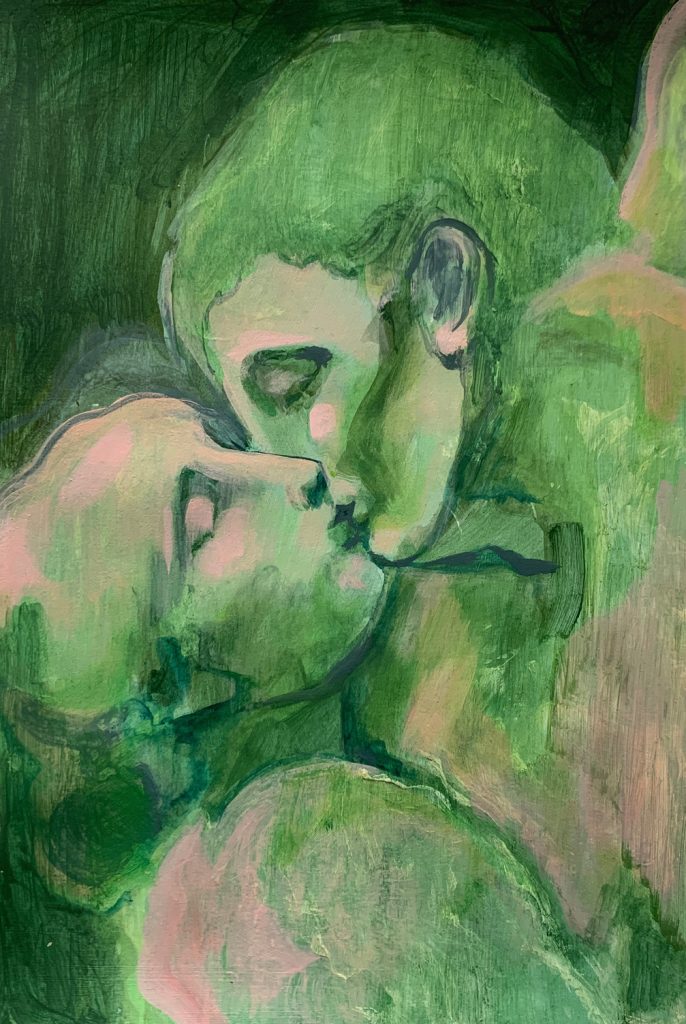
Your work is very otherworldly and evocative of classical and Renaissance imagery. Are you influenced by Renaissance artists such as Michelangelo, or the dreamy symbolism of Gustav Klimt?
Yes I do look at classical artists for inspiration. My painting style is much more reminiscent of neo-expressionism and has abstract sensibilities, but I like to position the figures in my paintings in poses that are inspired by classical and renaissance art. At the moment I am looking at cemetery sculptures such as Giulio Monteverde’s ‘Oneto Angel’ and the sculpture at the tomb of The Ribaudo Family, which was famously used on the cover for Joy Division’s ‘Love will tear us apart’ in the 1980s. Both sculptures are at the Staglieno Cemetery in Genova.
25% of sales from your exhibition ‘Mnemosyne’ at Purslane Gallery are being donated to domestic abuse charity Refuge. In the wake of the #MeToo movement, with the important topic of violence against women being hotly debated since the murder of Sarah Everard and the issue of misogyny and abuse of women raising its ugly head in schools too, do you think it’s important to address these issues in your artistic practice?
Art can often aid discussion surrounding difficult and sensitive social issues. As an artist I think it is important to not shy away from the nuances of the work you are creating. It’s suggestive nature means that a painting can have a totally different meaning from one viewer to the next based on their own personal experience. Meanings that can sometimes be perceived as more loaded or serious than you had intended. It can often occur naturally because of the subject matter that you are working with, but at the same time I don’t think it is necessary to ‘force’ a political message through your work. One of my recent paintings ‘Cassandra Syndrome’ started with some photographs of sculptures, one of which was ‘Cassandra’ by Ercole Drei. I painted this around March 8th and didn’t intend for it to directly address any particular current social issues. After finishing the piece I thought I would look into the mythology more before I chose the title. The mythology of Cassandra denoted that Apollo fell in love with her and granted her with the gift of prophecy. When Cassandra denied Apollo and his advances, he placed a curse on her, so that no one would believe her words or her predictions. He gave her a gift that would bring frustration and despair to her. Today this is a recognised modern syndrome, which is applied in cases of valid alarms which are disbelieved, mostly in psychology and science. This mythology could be used as a metaphor for the violence against women today and I think it’s only a positive thing if art can open up debate around certain social issues.
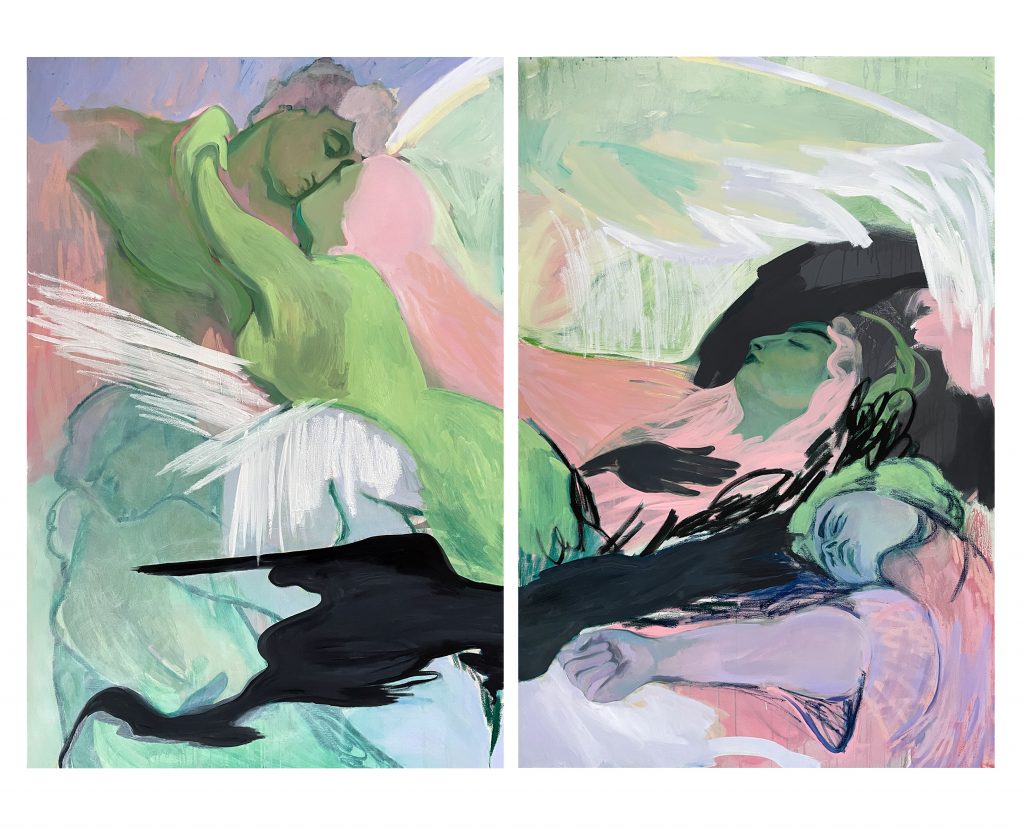
In an Artnet list of the Top artworks sold at auction in 2020, not one woman is featured (the list is topped by David Hockney, 13th Century artist Ren Renfa, Cy Twombly). Georgia O’Keeffe created the most expensive painting by a woman to be sold at auction (‘Jimson Weed/ White Flower No. 1 (1932) which sold for $44.4 million at Sotheby’s in 2014). There has historically been a huge gap between the sale price of work by male and female artists, and also in the representation of women in museum collections and exhibitions. Do you feel hopeful that this is slowly changing, and have you ever felt that you have met with barriers due to your gender?
I do feel hopeful that this is changing, however statistics like this seem to re-occur each year, so I’m not sure how much is changing at the top end. I am working with a number of galleries that are actively showing at least 50% female artists or sometimes higher, so at the emerging level I think there is real effort being made. I don’t think I have been met with many gender barriers yet but this is obviously not possible to truly gauge. There are some galleries that I have noticed seem to mostly show male artists. I’m not sure but it could be a matter of taste? There are still many preconceived ideas within society of what is feminine and masculine, and I have heard the term ‘too feminine’ relating to art but interestingly never ‘too masculine’. I do contemplate whether art that is seen as ‘too feminine’ may not be desired among some galleries and collectors. My work is very feminine and I am really proud of that, but I do wonder if this is sometimes seen as negative or undesirable by some. (My instagram following is only 20% male which I find interesting).
Could you tell me about the collaboration with Artsy and what the inspiration was behind the featured work?
I have an online solo exhibition on Artsy ‘Viewing rooms’ titled ‘The Torches Burn Bright’. The exhibition is presented by Offshoot Arts and features 8 paintings. Several paintings in this collection are inspired by Shakespeare’s iconic tragedy of star-crossed lovers ‘Romeo and Juliet’. Reminiscent of the dramatic poses of the divine saints from the Renaissance period, these figures hover between the classical and the contemporary. This collection of paintings both celebrate and explore the emotional intensity and intimacy of love. The Baz Luhrmann adaptation of the classic is one of my all-time favourite films and I wanted to make some paintings that had a direct reference to the story of Romeo and Juliet and also the aesthetic of the 1990s film.
What is your usual process, medium and starting point for your work?
I use traditional painting mediums such as acrylics, oils, oil bar and sometimes paper or fabric collage. I usually reference an image as a starting point but the way the paint reacts and the painting process often directs the outcome of the finished painting. The shapes, colours and brushwork created during the process form a visual language and help to suggest a narrative. I start with a figurative sketch which will become the subject or subjects within the composition. Image references range from fashion photography to classical paintings, neoclassical sculptures and Cemetery sculptures. I always take photos throughout the different stages of a painting; this helps me to look at the image as a whole and also at painterly details independently.
Any tips for young artists on how to get their work out there?
Work hard and do research. Have the confidence to make the kind of work that you want to and try to find galleries with open calls that show the kind of work you are making. Be patient and engage with galleries and other artists’ work you genuinely like. On the topic of Instagram, I think nowadays it’s important to be genuine as it’s obvious when you are doing it ‘for the likes’ etc. It can be frustrating but don’t get caught up on the amount of followers you have or how many likes you get. Focus on your work and do plenty of research into the business side of being an artist. There are lots of great podcasts to listen to; Talk Art, The Artists Contemporary, Artfully podcast and The Delphian Gallery podcast to name a few. The Delphian Gallery has also written a brilliant book ‘Navigating the Art World’ which I recommend to anyone who is looking for this kind of advice.
Amy Beager ‘The Torches Burn Bright’ is presented by Offshoot Arts online at Artsy until August 8th @amybeager
